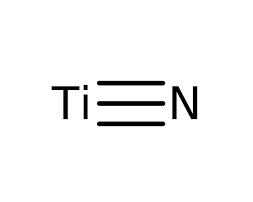Titanium nitride, also known as TiNite or TiN, is a chemical compound that is commonly used in coating objects. Titanium nitride thin film gives the coated object a gold color. It is widely used because it is less expensive than most other compounds with similar chemical properties. There are numerous commercial variants of titanium nitride, but the only known form of titanium nitride is Osbornite which is found in meteorites.
Properties of Titanium Nitride
Titanium Nitride has a lot of properties that make it more desirable than most noble metals.
- Titanium Nitride has a molar mass of 61.874g/mol.
- It is odorless.
- It is highly durable. It has a crystal structure similar to sodium chloride.
- It has high mechanical strength.
- It has a melting point of about 2947°C, making it appropriate for devices or appliances subjected to high temperatures.
- It is resistant to reactions with acids and bases.
- It is biocompatible. This means that TiNite has no adverse effects on humans or animals. Hence, It does not react with body fluid or body tissue.
Production of Titanium Nitride
Titanium nitride is produced from a metallic element (Titanium) and a non-metallic element (Nitride). These two elements undergo an irreversible chemical reaction before titanium nitride is formed. And the two methods commonly used to coat titanium nitride film are the physical vapor deposition (PVD) method and the chemical vapor deposition (CVD) method.

For the physical vapor deposition method, titanium metal powder is reacted with nitrogen gas. The titanium metal is converted into vapor in nitrogen plasma under low pressure. Electron beam evaporation can also be used to vaporize the titanium. When any of the two processes above is completed, a thin film of TiN is deposited on a material that has been subjected to a temperature of up to 200-500°C.
The chemical vapor deposition method is a little different. It requires the use of titanium tetrachloride, hydrogen, and nitrogen. By the end of this method, a thin film of titanium nitride is deposited on a material. The material must have been heated to more than a thousand degrees Celsius. Therefore, this method requires more energy (heat) than the physical vapor deposition method. Other methods used in the production of Titanium Nitride include:
- Reacting titanium metal powder with sodium azide: The sodium used for this reaction becomes very active as the solid reactants are heated in nitrogen.
- Heating titanium oxide with carbon powder in the presence of nitrogen: This is also known as the carbothermal reduction of titanium nitride.
Uses of Titanium Nitride
Titanium Nitride has a lot of uses. This is due to the many beneficial properties of the chemical compound. Some of the uses of this unique compound are:
Jewelry: Titanium Nitride has a yellowish color that makes it look similar to gold. However, it is very affordable in comparison with gold. This makes it ideal for coating jewelry. It gives jewelry the exquisite appearance of gold for a much lower cost.

Medicine: Thanks to the fact that TiN is biocompatible, it can be used to manufacture a good number of medical tools. It is safe under the FDA guidelines and is used to produce things like scalpel blades, orthopedic bone saws, and medical implants.
Bioelectronics: Titanium Nitride is used to coat many electrodes used in bioelectronic devices. Some of these devices include implants or biosensors placed inside of the body. TiN is suitable for this because it does not undergo corrosion when it comes in contact with body fluids. It is less volatile inside the body than most other metals.
Plastic Packaging: Titanium Nitride is considered to be a nanomaterial. Nanomaterials are known to improve the quality of packaging materials. They create an improved barrier for gas exchange between packaged food and the environment. This elongates the shelf life of the food, especially if it is a fruit or vegetable. It also releases ions which give the plastic packaging materials antimicrobial properties.
Cutting Tools: Titanium Nitride improves the service life of cutting tools. It can extend the service life of a tool by a factor of three or even four. This is because TiN is strong, wear-resistant, and heat-resistant. Cutting tools made with TiN have a sharper edge than tools made from materials like carbon steel.
Sliding Surfaces: TiN has lubricating properties. This makes it ideal for coating sliding surfaces. Sliding surfaces coated with Titanium Nitride are highly resistant to wear. These tools also have a low friction coefficient.
Conclusion
Durability, strength, and affordability are properties that are often looked out for in industrial materials, while titanium nitride embodies all these properties and even more. Considering the many beneficial properties and use of titanium nitride, it is easy to see how it aids the manufacturing and production of many essential items.
Thanks for reading. For more information about thin-film coating materials, please visit https://www.sputtertargets.net/.




